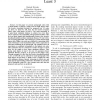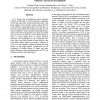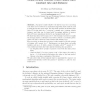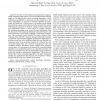76 search results - page 8 / 16 » Random codes: Minimum distances and error exponents |
GLOBECOM
2006
IEEE
14 years 23 days ago
2006
IEEE
— In this paper we present protograph codes with a small number of degree-3 nodes and one high degree node. The iterative decoding threshold for proposed rate 1/2 codes are lower...
IWDW
2005
Springer
14 years 6 days ago
2005
Springer
In a fingerprinting scheme a distributor places marks in each copy of a digital object. Placing different marks in different copies, uniquely identifies the recipient of each cop...
ICDAR
2009
IEEE
14 years 1 months ago
2009
IEEE
It is known that convolutional neural networks (CNNs) are efficient for optical character recognition (OCR) and many other visual classification tasks. This paper applies error-co...
ECCC
2011
12 years 10 months ago
2011
A q-query locally testable code (LTC) is an error correcting code that can be tested by a randomized algorithm that reads at most q symbols from the given word. An important questi...
TCOM
2010
13 years 1 months ago
2010
Abstract--In order to release the growing demand for computational complexity with respect to increasing information sequence length in the priority-first search decoding algorithm...




